Offered for sale is a rare original 1936
DOCUMENT SIGNED BY THE ONLY SS MAN PUNISHED BY THE NAZI REGIME FOR KILLING JEWS
SS-UNTERSTURMFüHRER MAX TÄUBNER
HE STOOD TRIAL NOT FOR THE KILLINGS BUT FOR TAKING PICTURES
SS-Untersturmführer Max Täubner who was assigned to the 1st SS-Infantry Brigade was the only SS man punished by the Nazi regime for killing Jews during the Holocaust. After the war, the charges against Täubner were dismissed because he had already been convicted and had served time.
Täubner got a job as Messerschmitt’s aircraft factory and joined the Luftwaffe in 1937. In 1941 he volunteered for the Waffen-SS and received the Untersturmführer degree with command of a maintenance squad. Täubner’s platoon and other units that were supposed to stay behind the front traveled to Ukraine in early September 1941, where the target was the town of Konotop, just north of Kyiv. Täubner and his platoon were maintenance units affiliated with the SS Brigade number 1.
Täubner and his troops probably killed several thousand Jews in Ukraine and Belarus on their own initiative. As they moved through Ukraine, most of the Jews had already been killed by Einsatzgruppe C and SS brigade number 1, and the slain surviving Jews they came across. Täubner and his troops massacred hundreds of Jews in Novohrad-Volynskyj, Sholokhovo and Oleksandrija, among others. In Novohrad-Volynskyj, the SS Brigade number 1, the Wehrmacht and Einsatzkommando had killed most of the city’s 6,500 Jewish residents. When Täubner arrived at the scene, the mayor told him that about 300 surviving Jews were being held in the local prison and that the Wehrmacht had issued certificates that these were not Jews. Täubner believed that the army showed too much concern and ensured that the Ukrainian militia shoveled up a large pit on the outskirts of the city. Täubner and his men forced the Jews (319 in total) to the ground and killed them with neck shots. In some cases, they massacred Jews whom the Wehrmacht had planned to use for forced labor, much to the annoyance of the commanders of the army. There are indications that they also killed Jews en route to their first deployment to Konotop. The platoon stayed in Oleksandrija from 22 October to 12 November 1941. Before the war, there were 4,300 Jews in the city, most of whom had already been killed by Sonderkommando 4b (a killing squad under Einsatzkommando C). Täubner had decided to kill the remaining ones. With the help of Ukrainian militia, he gathered Jews and kept them confined in the basement where he himself lived. Crews from Reichsarbeitsdienst volunteered to dig mass graves. According to the SS court, Täubner’s squad killed at least 459 Jews there. Soldiers from the Wehrmacht and German railway workers volunteered to shoot Jews. In Konotop, Täubner’s platoon was initially without duties because the SS Brigade Number 1 was redirected towards Moscow to reinforce the army at the Battle of Moscow. They then began searching the city and nearby villages for remaining Jews. The Wehrmacht assisted by handing over Jews accused of supporting the Communists. In the later trial, the number of people killed in and around Konotop was not accounted for. At the mass graves, Täubner happily brought his accordion to liven up the crew with music. In connection with the investigation and trial, Täubner described the murders and abuse in detail, without attempting to embellish the truth. Täubner was firm in his belief that they could do what they wanted with the Jews and were determined to fulfill Hitler’s wishes even if they had not been given concrete orders.
Täubner photographed the atrocities he carried out in Ukraine, including the killing of children and piles of corpses. He evoked the photographs in a regular photography laboratory in Germany and showed them to family and acquaintances, bragging about his “heroic” deeds in the east. The SS was afraid that the images (69 in total) would become publicly known which would be embarrassing for the SS, it could undermine morale in Germany and pose a security according to the SS. Täubner knew full well that photography was prohibited, and the SS took legal action against Täubner. In addition to Täubner, four of his subordinates were arrested in April 1942, the four subordinates later released without trial. In court, Täubner argued that the killings of Jews were no secret: “everyone knew and talked about it.” He argued that he and his men carried out murders according to the Führerbefehl. The SS’s investigator, Heinz Meurin, claimed that such an order was unknown, while the SS Brigade Number 1 (to which Täubner’s maintenance department was affiliated) operated on the condition of an assumed order from Hitler that their main task was to kill Jews. Himmler ordered that the photographs be destroyed immediately and after the trial he renewed his order that photography was strictly prohibited. The case was brought before an SS court in Munich. Täubner was the head of a workshop department and, according to the verdict, was not tasked with killing Jews (the phrase “none of the Jews who were killed is a great loss”) probably writes itself from oral instructions to the judges from Himmler: [The defendant shall not be punished for the murder of Jews as such. The Jews must be exterminated and none of the Jews who were killed is a great loss. Although the defendant should have understood that the responsibility for the extermination of the Jews lay with the commanders set up specifically for this purpose, he is excused for noting that he considered that he had the authority to participate in the extermination of the Jews himself. ]
Täubner was criticized for behaving unworthily and in a way that did not suit a German and SS man. The SS didn’t care much about what the photographs showed, but it was shocked by Täubner’s mindlessness and that it was very unfortunate to disseminate such images. Himmler is said to have repeatedly verbally and privately stressed that the killing of Jews was a Führerbefehl and that SS men should not be prosecuted for the murder of Jews, but Himmler would not publicly say anything about such an order from Hitler.
Täubner is described in the verdict as a fanatical Jew hater and the verdict describes several instances in which he, on his own initiative, arranged for his platoon to kill several hundred Jews in several rounds.
Heinrich Himmler was personally involved in the case. He was concerned about the lawlessness and lack of discipline that Täubner had shown. Himmler was obsessed with order and that his SS men should have high morale and act decently after carrying out mass killings. In connection with the case, Himmler in October 1942 drew up written criteria for when SS men could be prosecuted for unlawful killing of Jews “without authority or without order”: Murder of Jews only by political motive should not be punished, while acts of murder of selfish, sadistic or sexual motives could be punished as murder. Himmler’s legal memo somehow gave the SS and the police the right to kill Jews at their discretion. Täubner was convicted in May 1943 for the photography and for misconduct in the conduct of a German and an SS officer. He was sentenced to 10 years in prison and served time in Dachau until he was pardoned by Himmler in January 1945. It is not known whether anyone other than Täubner was convicted of murder according to Himmler’s criteria from October 1942. He was convicted of lack of discipline and obedience, not for the killings. The court was led by SS-Standartenführer Dr. Günther Reinecke.
The SS judges probably destroyed most of the archives before the end of the war. The case against Täubner is one of the exceptions in which the documents survived. Täubner returned from Russia as a prisoner of war in 1949.
In 1959, West German authorities brought a case against Täubner for the murder of Jews. The case was rejected by the court on the grounds that he had already been convicted and he could not be re-sentenced under Article 103 of the German constitution. The German prosecution brought the case all the way to the federal Supreme Court with the same result. In 1973, Max Täubner testified in the case against one of the subordinates and Täubner could not remember what abuses he and his squad had carried out.
The document, dated 20 May 1936 and sent to the SS RSHA in Berlin, lists a number of documents Täubner sent to the RSHA to verify his and his fiancée’s Aryan bloodlines. This was required for every SS man who wanted to get married. Then SS-Rottenführer Täubner submitted 2 filled out ancestry charts, 2 filled out forms, 2 medical examination results charts as well as birth certificates of him and his future wife. The entire document is handwritten in ink by the only SS man who punished by the Nazi regime for killing Jews during the Holocaust.
This document ships from one of our affiliates in Germany. It comes from a private collection and has never been offered for sale before. It was purchased directly out of a German archive. The seller gives a full money back guarantee for the authenticity of the document and signature. Includes shipping worldwide.

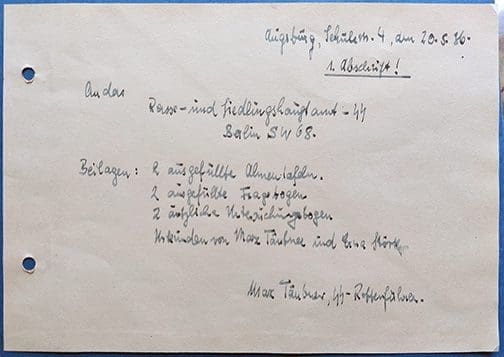

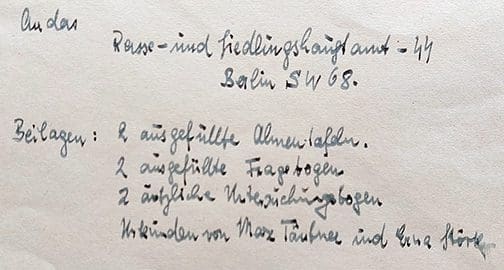
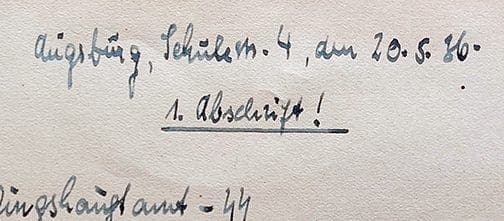
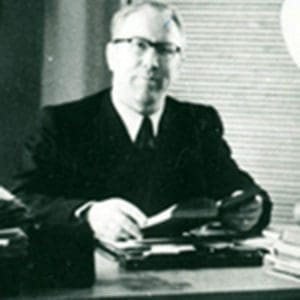
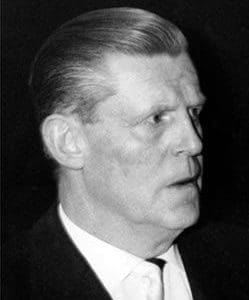
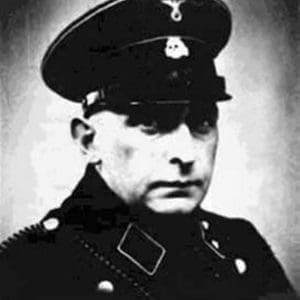
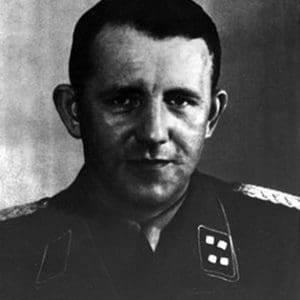
Reviews
There are no reviews yet.